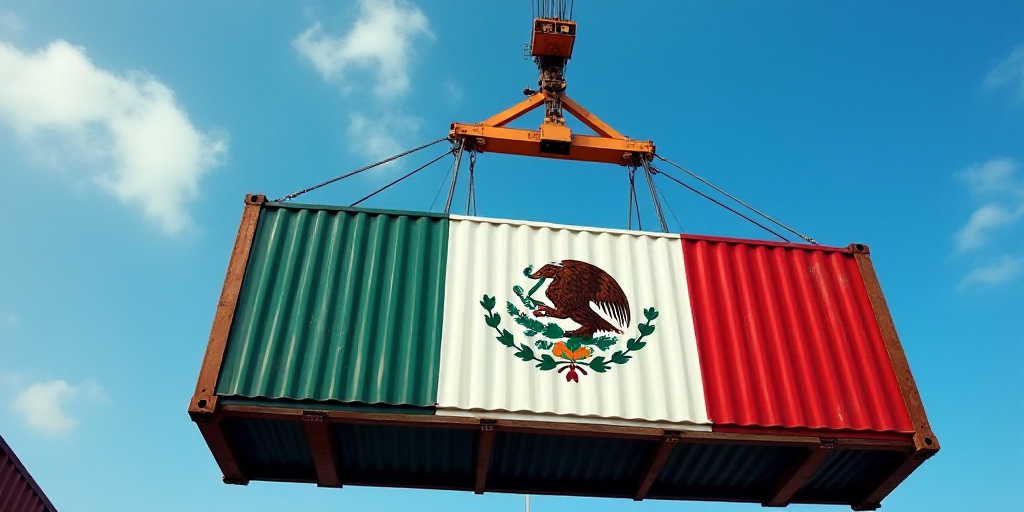Background on Mexico’s Trade Situation
Mexico’s exports of goods increased by 5.8% in April compared to the same period last year, reaching $54,295.7 million, partly driven by higher demand due to uncertainty over US tariffs. Meanwhile, imports fell 1.2%, totaling $54,383.8 million, resulting in a trade deficit of $88.1 million, according to the National Institute of Statistics and Geography (Inegi).
Experts’ Analysis
Luis Adrián Muñiz, an analyst at Vector, suggests that the impact of US tariffs on Mexican trade has not been fully observed yet. He points out that the decline in imports could be an early indicator of lower exports in May.
The balance of trade also anticipates a slowdown in consumption, fixed investment, and on the supply side, industrial production. The growth in exports is attributed to a 6.6% increase in non-oil exports and a 13.2% decrease in oil exports.
Gabriela Siller and Jesús Anacarsis López, analysts at Banco Base, emphasize that the growth is explained by higher demand for Mexican products due to uncertainty surrounding the US trade policy.
Impact of US Trade Policies
In April, the Trump administration announced “reciprocal” tariffs for the rest of the world and escalated its trade war with China, causing nervousness about the unpredictable measures the US government might take against its main trading partners.
Manufactured product exports totaled $49,015 million in April, marking a 6.6% annual growth. Notable increases were observed in machinery and specialized equipment for various industries (62.5%), household metal products (18.8%), professional and scientific equipment (18.5%), electrical and electronic equipment and appliances (6.4%), and minerometalurgical products (2.5%).
Automotive product exports, however, saw a 7.1% annual decline due to decreased sales to the US (-8.0%) and other markets (-1.3%).
Oil Export Performance
In April 2025, oil exports amounted to $1,833 million, comprising $1,265 million from crude oil sales and $568 million from other petroleum product exports.
The average export price for Mexico’s crude oil blend in April was $60.82 per barrel, a decrease of $4.97 from the previous month and $16.06 less than April 2024.
Crude oil export volume stood at 693,000 barrels per day, lower than March’s 811,000 barrels per day but similar to April 2024’s 698,000 barrels per day.
Implications for Mexican Economy
Banco Base analysts note that the sluggish growth in consumer goods and capital imports reflects weak domestic consumption and the peso’s 19.31% depreciation against the US dollar from April 2024 to April 2025, as well as investment uncertainty in Mexico. This contrasts with the acceleration in intermediate goods imports and aligns with anticipated growth in manufactured goods exports.
Key Questions and Answers
- What caused the rise in Mexican exports in April? The growth was primarily due to higher demand for Mexican products amid uncertainty over US trade policies.
- How did US tariffs affect Mexican imports? Imports fell 1.2% in April, possibly indicating a slowdown in exports for the following month.
- Which sectors experienced growth in exports? Machinery and specialized equipment for various industries, household metal products, professional and scientific equipment, electrical and electronic equipment, and minerometalurgical products all saw significant increases.
- What factors contributed to the decline in automotive product exports? Decreased sales to both the US and other markets led to a 7.1% annual decline in automotive product exports.
- How did oil export performance fare in April 2025? Oil exports totaled $1,833 million, with crude oil sales accounting for $1,265 million and other petroleum product exports making up $568 million.
- What do the analysts say about the Mexican economy’s future? The sluggish growth in consumer goods and capital imports, along with investment uncertainty, suggests weak domestic consumption. However, the acceleration in intermediate goods imports and anticipated growth in manufactured goods exports indicate a mixed outlook for the Mexican economy.






